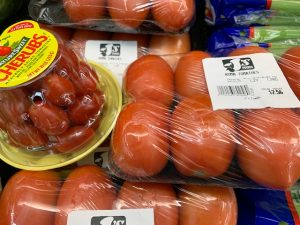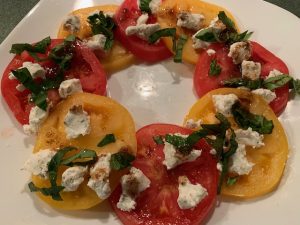Part III
Put On Your Chef Hat For Tomatoes!
Well now that we’ve travelled through the history of how tomatoes came to be such a staple in our pantry, after many trials and travails in Part I-Tomato History and Misconceptions and then we explored how tomatoes can act as medicine in preventing disease in Part II–Tomatoes Are Just What the Doctor Ordered!, we’ve saved the best part for last! Putting tomatoes to their best use as the main star of a dish or the complimentary partner or just that little extra that makes your culinary creations sing!
I was a little shocked when I looked through my camera roll of this past year’s meals I’ve created. A huge chunk of them included some type of tomato in many different applications.
Here’s a simple but flavorful slow-cooker chicken meal I made for Randy, Chicken Tiki Masala that starts with slow simmered (canned) fire-roasted tomatoes:

and Mozzarella Chicken with Grape Tomato Swiss Chard and Farro salad:

Just a side dish of a Stuffed Mediterranean Tomato:

and my traditional Sun-dried Tomato Pesto Goat Cheese Torte I make every year for Christmas:

And that’s not all, that’s just a sample! I didn’t mentally try to do that! Tomatoes just make an absolutely terrific marriage of flavors with meats, eggs, cheeses and vegetables! Tomatoes give just that right “pop” of sweet-tart acidity to cut through the protein and fat savoriness of a dish. What I recently discovered though was the reason why…..
I was reading about tomatoes in Harold McGee’s On Food and Cooking The Science and Lore of the Kitchen when I happened on:
What accounts for their great appeal? And why are these sweet-tart fruits treated as vegetables? I think the answer lies in their unique flavor. In addition to a relatively low sugar content for a fruit (3%), similar to cabbage and Brussel Sprouts, ripe tomatoes have an unusually large amount of savory glutamic acid (as much as .3% of weight), as well as aromatic sulfur compounds. Glutamic acid and sulfur aromas are more common in meats than fruits, and so predispose them to complement the flavor of meats, even to replace the flavor and add depth and complexity to sauces and other mixed preparations.
So, the vegetable profile of tomatoes (remember there’s a fruit side too-lol) give us that umami connection. Umami has now established itself as the fifth taste after salty, sweet, sour and bitter. Umami represents the savory taste of food. Glutamic acid (glutamate) is a non-essential amino acid (meaning the body can make its own, but it still needs food sources). And the umami taste comes through because our taste receptors respond to the glutamate, coupled with aromatic sulfurs in foods, which the tomato has a bountiful supply of both! Other foods besides tomatoes that tickle our umami taste buds are broths, gravies, soups, fish, mushrooms, yeast extract, soy sauce, meat extract, cheeses, eggs and vegetable protein.
So how can we make the best use of these (little and big) red sweet and savory gems? As I pointed out in Part II- Tomatoes are Just What the Doctor Ordered! , you receive the largest bounty of lycopene health benefit from cooking the tomatoes with a small amount of fat AND by leaving the skin on. However, fresh, raw tomatoes are still incredibly good for you, especially the Vitamin C content, which diminishes when you cook the tomatoes! And remember vine-ripened tomatoes have both the highest lycopene content and taste! So hit that Farmer’s market if you don’t already grow you own!
If green tomatoes are your thing, please fry or pickle them because the solanine content is high (poisonous chemical in raw tomatoes and their leaves) so it will dissipate. This was my first time creating a fried green tomato dish over chicken sausage, it was delicious!:

The types of tomatoes matter too! Cherry and grape tomatoes are terrific for salads, roasting and skewers (as I did with this appetizer when I catered a party):

Beefsteak tomatoes are great for a large slice on a sandwich or salad. And heirloom (or non-hybrid) tomatoes are best for roasting, as I did with this tomato pie recently:

And Roma are best for canning because they have fewer seeds, water content and are meatier in general to hold up to canning.
Here’s a pic of Roma and grape tomatoes. Fun fact: grape tomatoes are the babies of the Roma!!

Here are my top culinary cues to finish up:
1) Simple is best--Life is just too complex sometimes, so the goal I’ve tried to embrace, and I recommend to you too, is make the best flavored dishes, without a great deal of fuss.
This is a simple tomato caprese salad which consists of sliced tomatoes a little bit of basil, goat cheese and a maple balsamic salad dressing (I make a huge batch of it to have on hand):

And you can’t beat a simple tomato bruschetta appetizer (this was a recent first course “date night” in our home ) of simple chopped tomatoes, parmesan, kalamata olives and lemon on toasted French bread slices.

This is the tomato bisque soup I use for many purposes:

First, just the norm, a family fav, sandwich and soup!:

I then thickened it a little (by cooking it a little longer) and added extra Italian seasoning, transforming it into a sauce-base for my Turkey Pepperoni Pizza, Skinny Chicken Parmesan (see recipe- Part I- Tomato History and Misconceptions) and Lasagna Cupcakes (see recipe: Part II – Tomatoes Are Just What The Doctor Ordered!):
- Turkey Pepperoni Pizza
- Skinny Chicken Parmesan
- Lasagna Cupcakes
The tomato bisque soup I make is chock full of antioxidants like sautéed onions, garlic and fresh herbs with a small amount of extra virgin olive oil to make it a tasty umami delight in any meal venue!
2) A Slow Simmer Yeilds Layers of Flavor- I started a mini-culinary school called Kidz Can Cook where I teach 6- 5th graders at a time:

about the basics of culinary, including, learning about layers of flavor. They make a basic tomato sauce by first sautéing onions with 10 cloves of garlic (we press them in a garlic press to get that additional appreciation of where garlic cloves come from) then adding fire-roasted canned tomatoes and letting it simmer for 30 minutes before adding fresh parsley and a touch of honey, as needed, to balance the acidity at the end. This sauce is then ladled on the zucchini pizzas and the stuffed meatballs:

And this was the appetizer when the students fed their parents on the final class:

The students had the opportunity to try all the dishes in prior classes before they served their parents, when they graduated, on the final class. They all received an appreciation for what food tastes like when it’s allowed to slowly simmer, to build up depth of flavor.
I’ve noticed in recipes that I review to get new ideas for cooking that fast cooking is the norm because everyone’s time is so limited, but then so is the flavor (I’ve tried some of them!) The blessing that has come from the world’s current situation of quarantining is some of us might have a few more minutes in the day to make these dishes pop! Adding some additional simmering or roasting times to the right dishes has the result of building all those terrific flavors that just need the tincture of time to happen!
3) Skinny Up The Favs!- It’s like a sport to me to skinny up favorite dishes we all love BUT STILL RETAIN THE FLAVOR! This is what I did with both of these dishes, Skinny Chicken Parmigiana and Lasagna Cupcakes (I’ve previously shared these recipes with you in Part I- Tomato History and Misconceptions and Part II-Tomatoes Are Just What the Doctor Ordered!)
Below is a comparison of one serving of the traditional version of both compared to the skinnied down version:
- Traditional Lasagna
- Lasagna Cupcakes
- Traditional Chicken Parmesan
- Skinny Chicken Parmesan
They both (Lasagna Cupcakes and Skinny Chicken Parmesan) weigh in at 1/2 the calories and as you can see, the macro count (fat, carbohydrate and protein) is at least 1/2 or more of the original in all categories.
Here are some simple tips so you can do the same:
Pair down the fat source by at least 1/3 (butter, oil and cheeses) and see what it tastes like. If you don’t like it, add a little fat or maybe you can take a little away!
B. Baking > Frying- If you can, try to bake rather than fry, you can always save on fat calories, but still retain the flavor (and it cuts down on clean up time-lol)!
C. Homemade > Store-Bought- Most recipes call for you to just buy some store-bought tomato sauce to complete both dishes. Try making that ingredient, as I did with a tomato bisque soup, in bulk, so you can use it for many different recipes AND so that you can control the layers of flavor and freshness you add to the dish. You can regulate the thickness by slowly simmering on the stove either longer, or if too thick, add a little chicken broth. I promise it’s worth it!
I’ll end this Tomato Miniseries with this simple observation I’ve come to embrace: Cook (tomatoes of course, but everything else too) with and for those you love and I promise you’ll receive more than you can ever give!!!

Recap of: The Tomato Trilogy-Part III-Put On Your Chef Hat For Tomatoes!
1) Simple is best!
2) A Slow Simmer Yeilds layers of Flavor!
3) Skinny Up The Favs!
A. Skinny up the fat!
B. Baking > Frying
C. Homemade > Store-Bought
The Final Tomato recipe (in this series-lol)!! But first some background on a true (if done right) delicacy: tomato salads: Robert Courtine was a renowned French food writer (known for the infamous book The Hundred Glories of French Cooking) who always ordered a salade tomate or tomato salad as the first course, no matter where he went or how elegant the restaurant was. He believed this simple salad was the true test of a restaurant’s devotion to proper technique and good ingredients.
Now YOU can experience an example of what’s being served in the finest of restaurants in the comfort of your own home! Below is a very straightforward tomato salad recipe that takes minimal prep, but it has a couple of steps in it that make it exceptional! Examples are setting aside the tomatoes briefly after salting them to enhance the flavor profile and marinating the shallot and garlic in lemon juice to take the harshness of the raw allium family away. Super refreshing! Enjoy!

GRAPE TOMATO SALAD
Portions: 2
Ingredients:
3 cups grape or cherry tomatoes, halved
Kosher salt and ground black pepper
1/4 cup lemon juice
3 garlic cloves, minced
1 medium shallot, halved and thinly sliced
3/4 cup lightly packed fresh flat-leaf parsley
2 T. Extra-virgin olive oil
1/2 cup lightly packed basil, cut in slivers (chiffonade) or dill, roughly chopped.
1-2 T. Feta cheese (optional)
Procedure:
1. Toss the tomatoes with 1/2 tsp. salt and set aside.
2. In a small bowl, stir together the lemon juice, garlic, shallot and 1/2 tsp. salt and pepper and let marinate for 10 minutes.
3. After marinating, add the shallot mixture, parsley and oil to the tomatoes and toss well. Taste and season with salt and pepper.
4. Add basil or dill just before serving (see note below).
5. Use a slotted spoon and transfer salad to your serving dish of choice.
6. Sprinkle feta cheese on top if your choose.
Note- Don’t add the dill or basil (whichever you choose), until you serve it, both are delicate herbs that both discolor and wilt if added too soon.
*Recipe adapted from the book Milk Street, The New Rules, Recipes That Will Change the Way You Cook by Christopher Kimball
Nutrition Info per serving: 229 cal./14 g. fat/15.1 g. carbohydrate/11.3 g. protein







